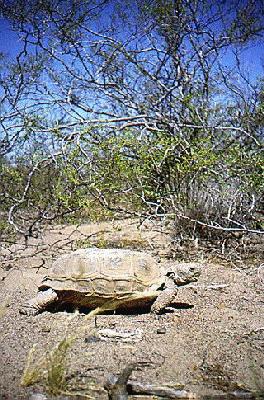 Adult female Patagonian tortoise in its sandy habitat. |
Land Use
|
ABSTRACT: Geochelone chilensis is similar in its ecology to Gopherus agassizii. It dwells throughout semi-xerophytic forests (Chaco) and desert scrublands (Monte) subjected to varying levels of human disturbance. Agriculture in these ecosystems is marginal, but it has a drastic impact on Geochelone habitat. For several decades forests and deserts throughout the tortoises’ range have been affected by free-ranging livestock, mainly goats but also cattle and sheep. Field studies conducted in desert habitats show that tortoises there depend on annual ephemeral plants and the summer fruits of various shrubs. The low densities and biased population structures related to the presence of livestock and the clear evidence of habitat disturbance suggest that free-ranging domestic mammals are threatening tortoise populations. Here, we hypothesize that livestock impacts Geochelone in the following ways: (1) domestic animals consume spring ephemerals and summer fruits more efficiently than do tortoises; (2) shrubs are sometimes seriously denuded by foraging and whatever vegetation survives falls prey to local burning practices, thus diminishing the overall diversity of perennials (which rarely recover because of the damage to emerging shoots); (2) fire injures or kills tortoises; and (3) livestock trampling destroys tortoise burrows and results in compacted soil, which also could affect plant regeneration. The end result of these processes is a uniform landscape of low floral diversity and an overall reduction in the quality of primary tortoise habitat. Populations are consequently marginalized to places such as road edges, sand hills, edges of salt lakes, and rugged landscapes where livestock seem to have low impact.
Threats to Habitat | Contents Summary |